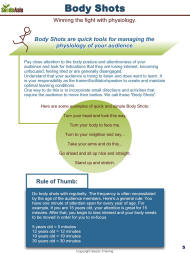|
State Changes
Learning requires energy.
Educators are brain-builders and keeping
the brain in an optimal learning state is a challenge. Knowing that
a good percentage of our students are body-based learners means that
we must creatively engage their bodies throughout the learning
process. We have
learned two tactical tools to do just that:
1. Body Shots
Body shots are quick, sometimes subtle methods for engaging
the body. The more they are practiced, the more in-grained
they become in the teachers way of working. They help to buy
the teacher a few more minutes of attention span. A few
examples of great body shots are:
- "Turn and look this way"
- "Turn and face me"
- "Turn to a neighbor and
say..."
- "Everybody take your....and
do this...."
- "Give your partner a high
five and say..."
When a body shot isn't enough
to please the restless kinesthetics, then move up a level to a
full state change. |
 |
2. State Changes
Level 2 of behavior management and
optimal learning state maintenance is a full blown state
change. These often require students to actually get up, move
their bodies, perform a task and re-assemble for the next
piece of learning/instruction.
Remember that the method of
delivering an effective state change without losing any
control goes as follows:
- "In ten seconds..."
- "When I say ....." (trigger
word and auditory loop)
- "You will have....seconds
to...." (time limit)
- Give a maximum of 3 clear
instructional chunks.
- "Go." or other trigger word.
- Use music at appropriate
volume and pace to drive movement.
- As soon as the music dips,
immediately begin with next learning piece
Practice makes progress. Use
these as needed and even get the students to help. Choose a
Captain Kinesthetic to cue you when they need a body shot or
state change. |
 |
|